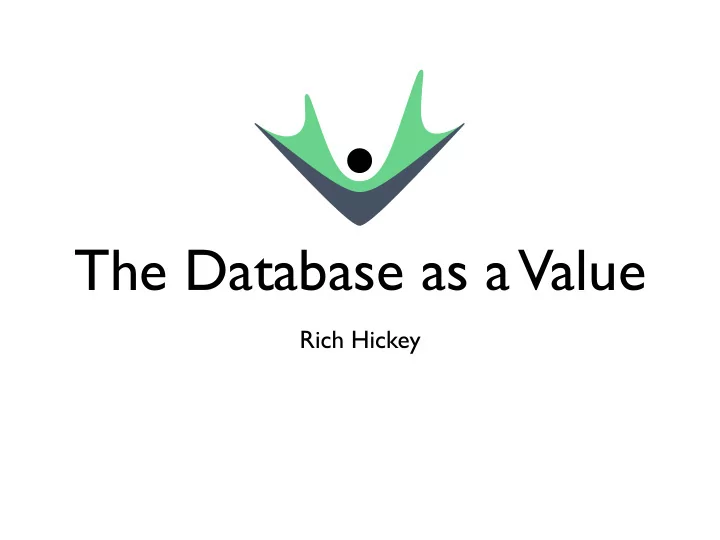

The Database as a Value Rich Hickey
Complexity • Out of the Tar Pit Moseley and Marks (2006) • Complexity caused by state and control • Close the loop - process
DB Complexity • Stateful, inextricably • Same query, different results • no basis • Over there • ‘Update’ poorly defined • Places
Basis • Calculation and decision making: may involve multiple components may visit a component more than once • Broken by simultaneous change
Update • What does update mean? • Does the new replace the old? • New ?? replace the old ?? • Visibility?
Manifestations • Wrong programs • Scaling problems • Round-trip fears • Fear of overloading server • Coupling, e.g. questions with reporting
The Choices • Coordination • how much, and where? • process requires it • perception shouldn’t • Immutability • sine qua non
Coming to Terms Value State • An immutable • Value of an identity at a magnitude, quantity, moment in time number... or immutable Time composite thereof • Relative before/after Identity ordering of causal values • A putative entity we associate with a series of causally related values (states) over time
Epochal Time Model Process events (pure functions) F F F v1 v2 v3 v4 States Identity (immutable values) (succession of states) Observers/perception/memory
Implementing Values • Persistent data structures • Trees • Structural sharing
Structural Sharing Next Past
Place Model Process events Transactions (pure functions) F F F The Database Place Identity DB (succession of Connection states) Observers/perception/memory Queries
Epochal Time Model Process events Transactions (pure functions) F F F v1 v2 v3 v4 States DB Values Identity (immutable values) DB (succession of Connection states) Observers/perception/memory Queries
Database State • The database as an expanding value • An accretion of facts • The past doesn’t change - immutable • Process requires new space • Fundamental move away from places
Accretion • Root per transaction doesn’t work • Crossing processes and time • Can’t convey/find/maintain roots • Can’t do global GC • Instead, latest values include past as well • The past is sub-range • Important for information model
Facts • Remove structure • a la RDF • Atomic • Datom • Entity/Attribute/Value/Transaction • Must include time
Process • Reified • Primitive representation of novelty • Assertions and retractions of facts • Minimal • Other transformations expand into those
Implementation
State • Must be organized to support query • Sorted set of facts • Maintaining sort live in storage - bad • BigTable - mem + storage merge • occasional merge into storage • persistent trees
Accumulate + Merge DB Engine Storage Transaction Processing Log Indexes Memory Indexes Index Merge
Datomic Architecture App Process Peer Lib App Query Live Comm Cache Index Data Segments Storage Service Transactor Trans- Data Segments Indexing actions Segment storage Redundant segment storage
Memory Index • Persistent sorted set • Large internal nodes • Pluggable comparators • 2 sorts always maintained • EAVT, AEVT • plus AVET, VAET
Storage • Log of tx asserts/retracts (in tree) • Various covering indexes (trees) • Storage requirements • Data segment values (K->V) • atoms (consistent read) • pods (conditional put)
What’s in a DB Value? Identity Memory index (live window) db atom db value live Storage index history nextT asOfT sinceT Lucene index Storage-backed index live Lucene Roots EAVT AEVT VeAET t Value Hierarchical Cache
Index Storage T EAVT AEVT VeAET AVET Lucene 42 Index Root of key->dir dirs Sorted segs Datoms Storage Service
Process • Assert/retract can’t express transformation • Transaction function: (f db & args) -> tx-data • tx-data: assert|retract|(tx-fn args...) • Expand/splice until all assert/retracts
Process Expansion + + - foo - + + + + - bar baz - + + + + - + + + - + - + + ...
Transactor • Accepts transactions • Expands, applies, logs, broadcasts • Periodic indexing, in background • Indexing creates garbage • Storage GC
Peers • Peers directly access storage service • Have own query engine • Have live mem index and merging • Two-tier cache • Segments (on/off heap) • Datoms w/object values (on heap)
DB Simplicity • Epochal state • Coordination only for process • Same query, same results • stable bases • Transactions well defined • Functional accretion
Other Benefits • Communicable, recoverable basis • Freedom to relocate/scale storage, query • Time travel - db.asOf, db.since, db.asIf • Queries comparing times • Process events
The Database as a Value • Dramatically less complex • More powerful • More scalable • Better information model
Thanks for Listening!
Recommend
More recommend